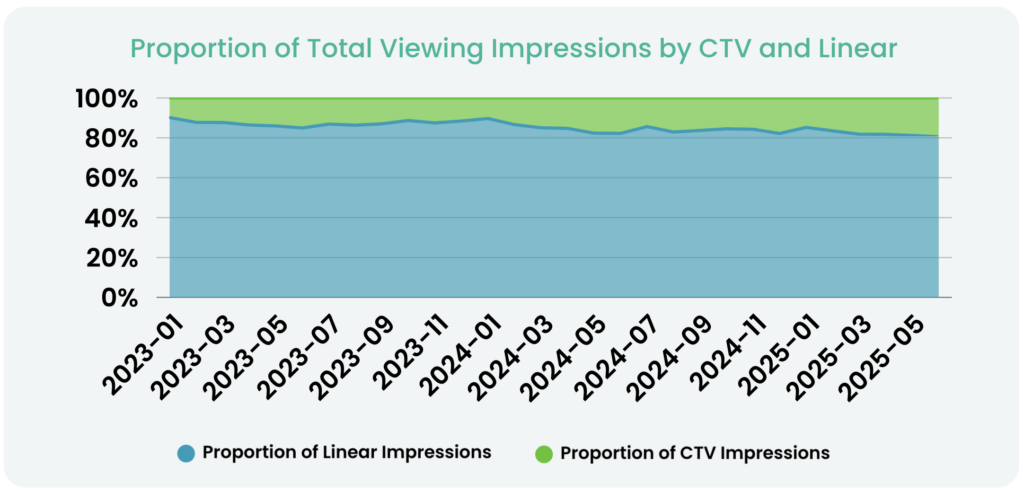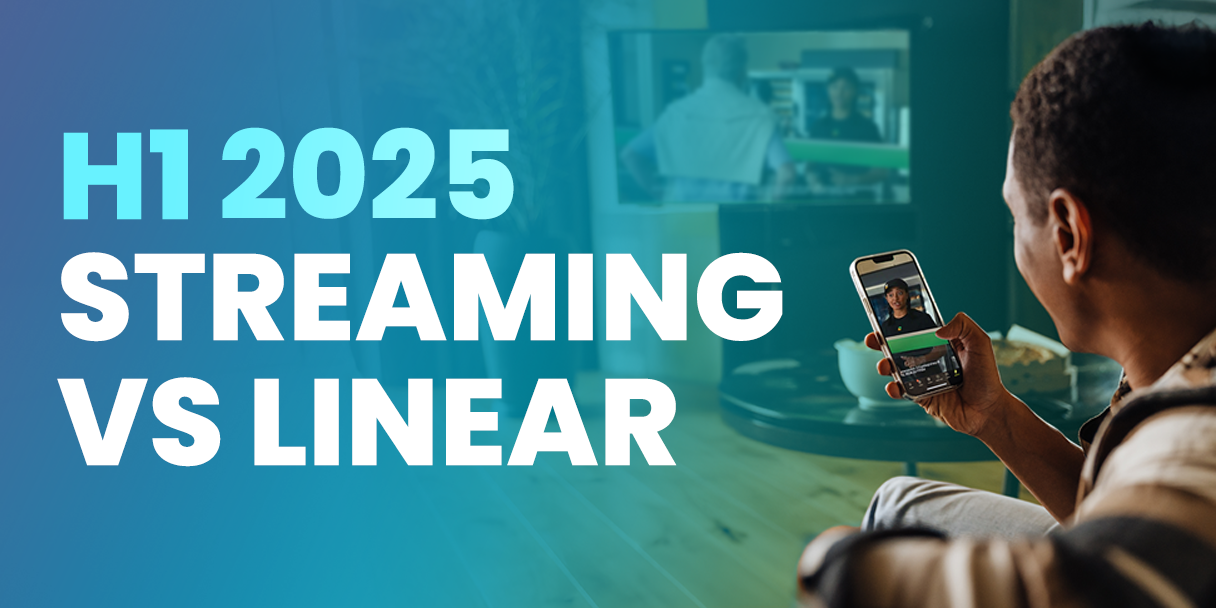The streaming surge is real. In H1 2025, CTV’s share of ad impressions jumped 31.91%, climbing from 14.76% in January to 19.48% by June. What started as a complement to linear TV is now becoming the main act for many advertisers.
But those advertisers aren’t just shifting spend. They’re using unified, cross-platform measurement to see streaming and linear together, pinpoint incremental reach, and optimize every dollar.
So, which advertisers are going all-in—and how does that look across categories?
This blog unpacks share of voice trends across key verticals, using a consistent set of 50 brands tracked across both linear and streaming from January 2023 through June 2025. Though not an exhaustive view of every advertiser, it offers a telling snapshot of where and how strategies are evolving at scale.
Let’s break it down.
Still a Linear World… But Shifting
Yes, linear still accounts for the bulk of impressions (80.52% in June), but that’s down from January, and the balance continues to tip. With FAST platforms multiplying and digital-native targeting strategies seeping into traditional budgets, the shift is happening.
To capture its full value, advertisers are leaning into unified, cross-platform measurement that deduplicates reach and frequency across linear and streaming—and connects every impression to real outcomes. Seeing total video performance in one view makes it possible to reallocate spend, manage frequency, and prove conversions with precision.

Combined linear and streaming data for a consistent set of 50 brands, analyzed from January 2023 through June 2025.
Streaming Share by Vertical: Who’s Leading the Charge?
Some verticals are making streaming work harder for them: Targeting smarter, diversifying creative, and capitalizing on the flexibility that CTV offers.
Here’s where streaming played a starring role:
Quick Serve Restaurants (QSR)
Taco Bell ranked #14 on streaming vs. #100 on linear—a big contrast driven by audience alignment and a larger creative footprint on digital platforms. McDonald’s, Chick-fil-A, and Wendy’s all had higher SOV on streaming vs. linear, signaling local targeting plays and a need to match creative with context.
Automakers
Hyundai, Nissan, and Toyota turned up their streaming SOV in H1, making strategic use of CTV to deliver more personalized and timely messaging.
Financial Services
Even though linear delivered a larger share of impressions for Intuit Credit Karma (0.47% vs. 0.33%), the brand leaned on streaming to diversify creative—running a wider mix of unique ads on CTV in H1.
See the full list of most-seen brands on streaming and linear by industry in the H1 TV & Video Transparency Report.
But Linear Still Has Its Champions
Insurance brands like Allstate and Liberty Mutual maintain strong linear presence, leveraging massive reach for message frequency. Retail giants like Walmart and The Home Depot use linear’s scale for broad seasonal messaging. Even in QSR, Subway sticks with linear’s appointment viewing during peak meal times.
Some brands are spreading their bets—Liberty Mutual maintains top-tier placement across both linear (#6) and streaming (#3), while Burger King appears to lean slightly toward streaming, ranking #2 there compared to a still-strong #13 on linear.

4 Takeaways for Marketers
1. Streaming Can Be a Creative Laboratory
Brands like Credit Karma are using CTV’s flexibility to run more unique creatives, enabling better audience segmentation and message testing at scale. Think of streaming as your creative sandbox—a place to experiment, learn, and optimize.
2. Local Targeting is Streaming’s Superpower
QSRs are cracking the code here. Higher SOV on streaming allows them to geo-target effectively, especially around promotions, tentpoles, or limited-time offers.
3. Industry Leaders Are Moving Fast
Even traditionally linear-heavy categories are embracing streaming’s targeting capabilities. Take auto: for a category once tightly tethered to prime-time, top automakers are using streaming to test, refine, and tailor messaging by audience group. The brands that adapt quickly are gaining competitive advantages that will be hard to replicate.
4. SOV Is Just the Starting Point
Knowing where your ads run matters, but measuring how they perform across creative variants, audience segments, and business outcomes is what transforms impressions into impact. Always-on measurement that captures the full spectrum of video performance puts marketers firmly in control of campaign performance—and their ROI.
The Cross-Platform Truth
As streaming’s share continues climbing, the brands winning are those treating it not as a linear TV extension, but as a fundamentally different medium with unique strengths.
They’re using precise targeting, creative variety, and unified, always-on measurement to see—at the ad level—how every impression performs, then optimizing in real time to drive results broad-reach linear simply can’t match.
The question isn’t whether streaming will continue growing; it’s whether your brand will be among those leading the charge or playing catch-up—with the measurement in place to prove every dollar’s impact.
Ready to go deeper? Download the complete H1 2025 TV Transparency Report for the industry intelligence that’s driving smarter advertising decisions.
